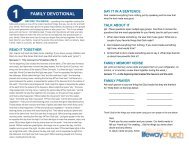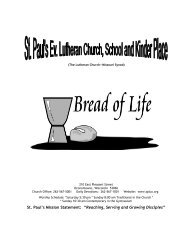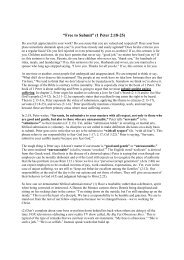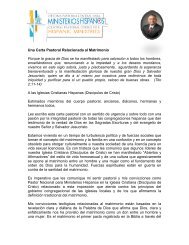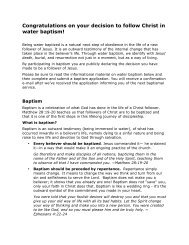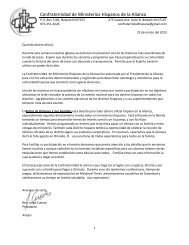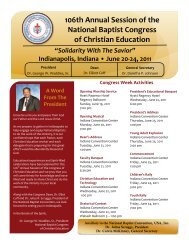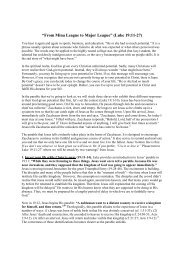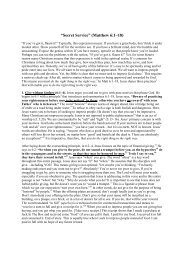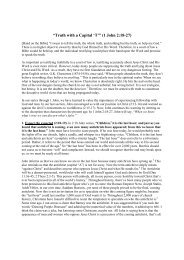A Proposal to Reduce Unnecessary Divorce - Razorplanet
A Proposal to Reduce Unnecessary Divorce - Razorplanet
A Proposal to Reduce Unnecessary Divorce - Razorplanet
You also want an ePaper? Increase the reach of your titles
YUMPU automatically turns print PDFs into web optimized ePapers that Google loves.
54<br />
24. Frank F. Furstenberg, Jr., and Andrew J. Cherlin, Divided Families: What Happens<br />
<strong>to</strong> Children When Parents Part (Cambridge, MA: Harvard University Press, 1991),<br />
21.<br />
25. Diane Vaughn, Uncoupling: Turning Points in Intimate Relationships (Oxford<br />
and New York: Oxford University Press, 1986).<br />
26. This point has been made by lawyers in the Family Law Marital Reconciliation<br />
Option Project.<br />
27. John Crouch et al., “<strong>Divorce</strong> Rates and Laws: USA & Europe,” <strong>Divorce</strong> Reforms<br />
Page, Americans for <strong>Divorce</strong> Reform, http://www.divorcereform.org/compare.html.<br />
We computed the percentage difference in divorce rates from the table in this source.<br />
States with no waiting periods averaged 4.04 divorces per 1,000 population; those with<br />
waiting periods averaged 3.57 divorces per 1,000 population, a 12 percent difference.<br />
28. Leora Friedberg, “Did Unilateral <strong>Divorce</strong> Raise <strong>Divorce</strong> Rates?: Evidence from<br />
Panel Data,” American Economic Review 88, no. 3 (June 1998): 608–27.<br />
29. Thorsten Kneip and Gerritt Bauer, “Did Unilateral <strong>Divorce</strong> Laws Raise <strong>Divorce</strong><br />
Rates in Western Europe?” Journal of Marriage and Family 71, no. 3 (August 2009):<br />
592–607. The researchers found that de fac<strong>to</strong>r unilateral divorce, which they measured<br />
as changes in waiting periods that occurred in many countries before unilateral divorce<br />
was introduced in<strong>to</strong> law, was the main fac<strong>to</strong>r increasing divorce, not the changes<br />
in law (de jure).<br />
30. In addition, some studies lump <strong>to</strong>gether a variety of fac<strong>to</strong>rs that inhibit divorce,<br />
such as fault proceedings, making it difficult <strong>to</strong> tease out the effects of waiting periods<br />
alone.<br />
31. Robin Fretwell Wilson, “Evaluating Marriage: Does Marriage Matter <strong>to</strong> the Nurturing<br />
of Children?” San Diego Law Review 42, no. 3 (2005): 848–81.<br />
32. For example, the results of a 2010 CBS News poll indicate that “a majority of<br />
Americans (53 percent) thinks getting a divorce is <strong>to</strong>o easy and should be made more<br />
difficult <strong>to</strong> obtain than it is now, while one in four Americans thinks getting a divorce<br />
should be made easier. These numbers are similar <strong>to</strong> those found in polls conducted<br />
by the University of Chicago over the past 20 years.” CBS News, “Poll: 63% Know<br />
Spouse Who Cheated,” CBS News.com, January 8, 2010, http://www.cbsnews.com/<br />
s<strong>to</strong>ries/2010/01/05/earlyshow/main6059795.shtml.<br />
33. Richard Crouch, “Transcript of Clin<strong>to</strong>n on <strong>Divorce</strong> Waiting Periods & Counseling,<br />
Politics of <strong>Divorce</strong> Prevention,” The Family Law News Blog, March 18, 2010, http://<br />
familylaw.typepad.com/family_law_news/2010/03/transcript-of-clin<strong>to</strong>n-on-divorcewaiting-periods-counseling-politics-of-divorce-prevention.html.



